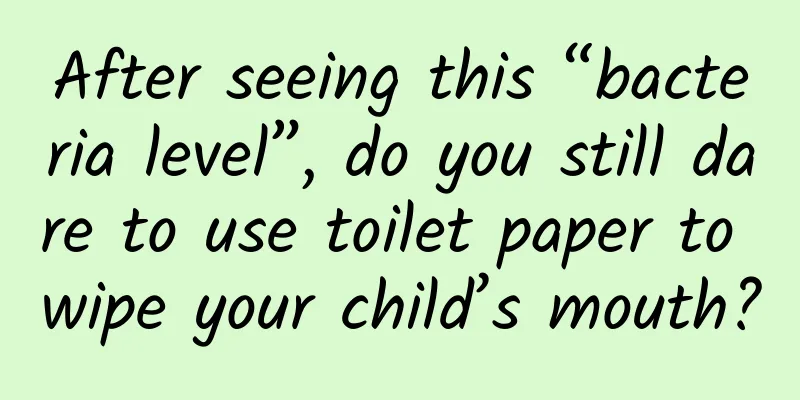After seeing this “bacteria level”, do you still dare to use toilet paper to wipe your child’s mouth?

|
Audit expert: Zhu Guangsi Member of Beijing Science Writers Association In recent years, a light yellow paper has become increasingly popular when it comes to toilet paper and napkin paper. It is called "unbleached and additive-free" by merchants. This is natural color paper. Thanks to the promotion of merchants, people think that natural color paper is healthier than ordinary paper, and using natural color paper has become a new habit for many people. However, if I tell you that there is essentially no difference between natural color toilet paper and ordinary white toilet paper, would you feel that your IQ has been trampled on again? Natural paper tissue and ordinary paper tissue Is plain paper more harmful than natural paper? In the market, natural paper is often more expensive than ordinary paper. However, the actual quality difference between the two is not that big. The raw materials of ordinary paper are mostly wood pulp, while the raw materials of natural paper are mostly bamboo pulp. Due to the original warm yellow color of bamboo pulp, the manufactured paper will be closer to the "natural color" . However, from the perspective of raw materials, both are common pulps and there is no obvious difference in terms of health. The final color difference between the two types of paper is reflected in the processing process: after steaming, bleaching agents need to be added to make ordinary paper, while natural paper is directly processed from bamboo pulp. Source of natural paper processing丨Science China This is the key step that makes the two different in the end, and bleaching is also the point that consumers pay the most attention to. Is ordinary paper with bleach added necessarily harmful to users? Chlorine or chlorine-containing compounds such as hypochlorous acid are indeed added to pure white toilet paper during the bleaching process, but after repeated washing, the content will drop to an extremely low level, meeting the requirements of the national standard (GB/T20808). The fluorescent brighteners that consumers are worried about have long been banned by the state. Researchers have used ultraviolet waves to test the fluorescence of four major brands of ordinary paper. Generally speaking, if there is fluorescent agent in the paper, blue flakes will appear under ultraviolet light, but after testing, none of the four brands showed blue flakes. No fluorescent whitening agent is present Source: Southern Metropolis Daily In addition, some consumers are also concerned about the presence of talc, dioxins and other substances in ordinary paper. As for talcum powder, it is allowed to be used in food processing , so it is not wrong to add it to paper. As for dioxins, you can be more assured. In the national standard (GB20808), the residual amount of related harmful substances is strictly controlled. Carcinogens such as dioxins are even less likely to appear on skin-friendly paper. Having said that, it is not difficult to conclude that, in fact, regular, big-brand ordinary paper is not "harmful" . Compared with ordinary white paper, natural paper has one less bleaching process. In principle, it can be said that there is no bleaching agent added, and there will be no bleaching agent residue on the paper. However, there will always be other compounds in the paper during processing and production, so the real health still depends on the comprehensive indicators of the factory. Paper can only be produced if the content of the relevant compounds meets the national standards. In fact, there is no big difference between the national quantitative standards for natural paper and ordinary paper. As long as you use regular brands of toilet paper, it will not cause harm to your health. Natural paper complies with QB-T 4509-2013 Source: National Standard Information Public Service Platform Ordinary tissue paper mostly complies with GB/T 20808-2011 Source: National Standard Information Public Service Platform In addition, since natural paper does not undergo a bleaching process, the lignin content of natural paper is retained to a greater extent, and the paper towels produced will be slightly harder. In the softness test of five products of ordinary paper and natural paper, the research results show that the softness of the five white paper samples is between (78-148) mN, which is generally softer, while the softness of the five natural paper samples is between (111-150) mN, which is relatively rough. This shows that natural paper is rougher than ordinary paper, has a poorer user experience, and is often not as comfortable as white paper. At the same time, the identification also includes evaluations of other dimensions, including fluorescent whitening agent content, lateral liquid absorption height (water absorption performance), lateral tensile index (tear resistance), and longitudinal wet tensile index (tear resistance after water absorption). The results showed that compared with ordinary paper, natural paper was more likely to be torn and fragmented before and after absorbing water, and its water absorption performance was also inferior to that of ordinary paper. It is worth mentioning that no fluorescent brightener was detected in either natural paper or ordinary paper in this experiment. From this, we can confirm that when purchasing regular brand paper, both natural color paper and ordinary paper are harmless to the human body, and there is almost no difference in the impact on human health between the two. The performance of natural color paper is also inferior to that of ordinary paper. Here's what you need to know when choosing paper! First of all, when choosing paper, we need to pay attention to whether we are buying roll paper or tissue paper. The requirements for bacterial content of the two are different. The implementation standard of toilet paper is GB20810, where the total bacterial colony count is less than 600 cfu/g, and the implementation standard of facial tissue is GB20808, which requires the total bacterial colony count to be less than 200 cfu/g. The limit requirements for bacteria in toilet paper are lower than those in facial tissue, so toilet paper is not suitable for wiping the mouth, face, etc. Toilet paper source: pexels At the same time, pay attention to the raw materials marked on the paper: such as virgin wood pulp, virgin pulp and pure wood pulp. Virgin wood pulp refers to pulp made entirely from natural wood. This type of pulp contains a higher fiber content, and the paper produced is finer and softer. Virgin pulp is pulp from natural plants, including but not limited to wood pulp, grass pulp, etc., and is of lower grade than virgin wood pulp. The term pure wood pulp is quite confusing, as it only means that all the pulp comes from wood, but in fact it may come from recycled virgin wood pulp, waste paper pulp, etc., and the quality of the paper made from it is the lowest. Source: Zhihu In short, there is actually not much difference between ordinary paper and natural color paper, and there is no obvious difference in the impact on human health. When buying paper, just choose a regular brand and buy it according to your needs. |
>>: What is a tsunami warning buoy? Do you know what it does?
Recommend
Will this winter be colder?
summary Since this autumn (September 1 to October...
6 ways to use countdown posters, how many have you seen?
Starting from July 21, Mr. Jia Yueting, Chairman ...
Fu Wantong's Commercial Font Design Course will end in July 2021 [HD quality with material]
Fu Wantong's Commercial Font Design Course wi...
Can retention rate be calculated this way?
The concept of retention rate is not unfamiliar to...
TSMC: Nvidia Blackwell chip orders account for more than 70% of CoWoS-L packaging capacity in Q1 2024
According to a recent report by Taiwan media Econo...
LeTV TV's ecological operation breaks the traditional price thinking
Yesterday, 60,000 LeTV TV Super TVs S40 Air and S...
Here is a Valentine's Day marketing promotion guide, please check it out!
Show affection and give gifts as they should (the...
Ford and Baidu jointly conduct autonomous driving tests, and L4 autonomous driving is expected to be accelerated
On October 31, Ford and Baidu announced that they...
Those mobile phone manufacturers that have been favored by Alibaba
Nowadays, in the technology industry, you have to...
How to choose your first programming language based on what you want in life
[[155653]] Life is easy for programmers. There ar...
7 eating habits that cancer cells love most. Avoid them from now on
Planning and production Author: Pan Zhanhe, Chief...
Dingxiang Doctor APP product analysis!
How is an excellent product designed, what princi...
Price inquiry for Zhangzhou Aquatic Products Mini Program agent. How much is the price for Zhangzhou Aquatic Products Mini Program agent?
For entrepreneurs, although mini program developm...
Data Report | Is automotive industry promotion ineffective? See how peers invest...
During the period of 2011-2017, the scale of Chin...









